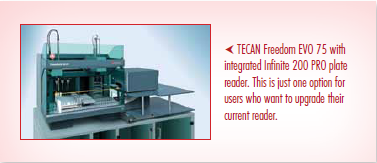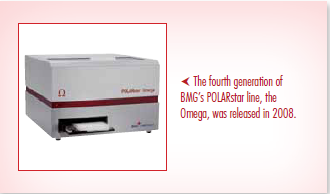Time to Upgrade? Microplate Readers
Need for new abilities drives upgrades and new purchases
The need for new capabilities— for new experiments and assays—is the major reason end-users need to either upgrade their current microplate readers or buy a new instrument.
Edward Dell, Ph.D., BMG LABTECH international marketing director, adds that microplate readers often have multiple users, meaning there is lots of wear and tear on these instruments. Filters are also known to degrade over time and moving parts such as motors and belts can become misaligned.
If maintenance can’t fix these problems, the reader will likely need to be replaced.
One of the ways to keep a microplate reader going is to have an annual QCPM (quality control preventive maintenance) check,” Dr. Dell said of how users can avoid problems like this. He added the lifecycle for most microplate readers tends to be three to five years, though BMG recently had a customer whose microplate reader served for 18 years before needing replacement.
 “They finally put it to bed because the computer operating system was out of date and we couldn’t find the computer operating system to run that software version anymore,” Dr. Dell said. “So the instrument didn’t actually break down but the computer running the instrument broke down.”
“They finally put it to bed because the computer operating system was out of date and we couldn’t find the computer operating system to run that software version anymore,” Dr. Dell said. “So the instrument didn’t actually break down but the computer running the instrument broke down.”
The decision on whether or not to add new features to a current reader, or purchase a new system with the latest and greatest technology mostly comes down to budget.
 “It’s simply an issue when enough money is available,” said Dr. Michael Fejtl, detection market manager at TECAN Austria.
“It’s simply an issue when enough money is available,” said Dr. Michael Fejtl, detection market manager at TECAN Austria.
If the budget is large enough and a user needs many capabilities or expects to need them down the road, it’s probably a good idea to invest in a fully-loaded, futureproof instrument, Dr. Fejtl said.
For example, TECAN’s M1000 PRO microplate reader, has temperature correction for AlphaScreen assays, and a QUAD4 monochromator for free wavelength selection and adjustable bandwidth, meaning that users wouldn’t need to upgrade in the future..
However, if money is tight, microplate reader companies offer a variety of features—such as chemical injectors for faster, more complex assays—that can be added to users’ current readers.
 “If a user starts with absorbance and fluorescence, an upgrade of the plate reader with luminescence detection and injectors allows them to read flash luminescence based assays.” Dr. Fejtl explained. Software upgrades can also add new capabilities to your current reader, Dr. Dell said.
“If a user starts with absorbance and fluorescence, an upgrade of the plate reader with luminescence detection and injectors allows them to read flash luminescence based assays.” Dr. Fejtl explained. Software upgrades can also add new capabilities to your current reader, Dr. Dell said.
“Software updates allow functionality in the reader that may not have existed two years ago,” he said. “Not just software updates to the data, but software updates to run the instrumentation.”
Drawbacks to upgrading a current reader, especially if it’s an older model, mean that users won’t have the absolute best technology available. Newer technology has more features, greater sensitivity, flexibility, and (usually) speed. Adding features to a current reader also takes time.
 “It takes some time and additional money, but it is generally accepted that the benefit of an upgrade option is always an advantage,” Dr. Fejtl said.
“It takes some time and additional money, but it is generally accepted that the benefit of an upgrade option is always an advantage,” Dr. Fejtl said.
Both experts said users need to be sure to ask about future upgradeability when making an initial purchase of a microplate reader, especially if they know they will need to add features later.
“It always depends on the application customers want to run and biological questions they would like to address,” Dr. Fejtl said.
OTHER THINGS TO CONSIDER WHEN DECIDING WHETHER OR NOT TO BUY NEW:
- Do you really need all the bells and whistles a new reader offers?
- Could adding features or upgrading the software on your current reader meet your needs?
- What kind of sensitivity do you need for your assays? Will your older reader be sensitive enough, even if you upgrade it?
- What kinds of options for improving your workflow are available for your current reader or a new one?
